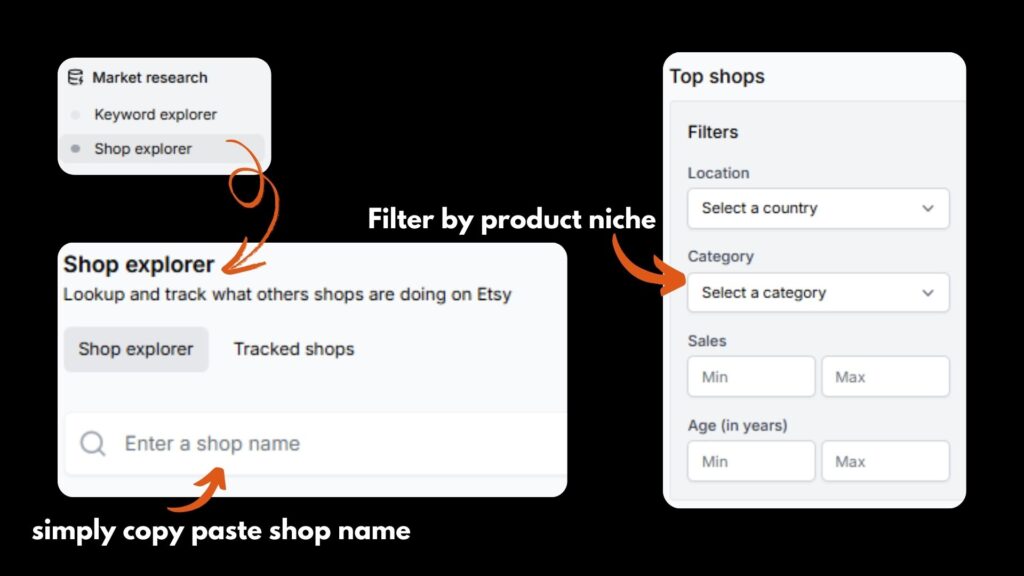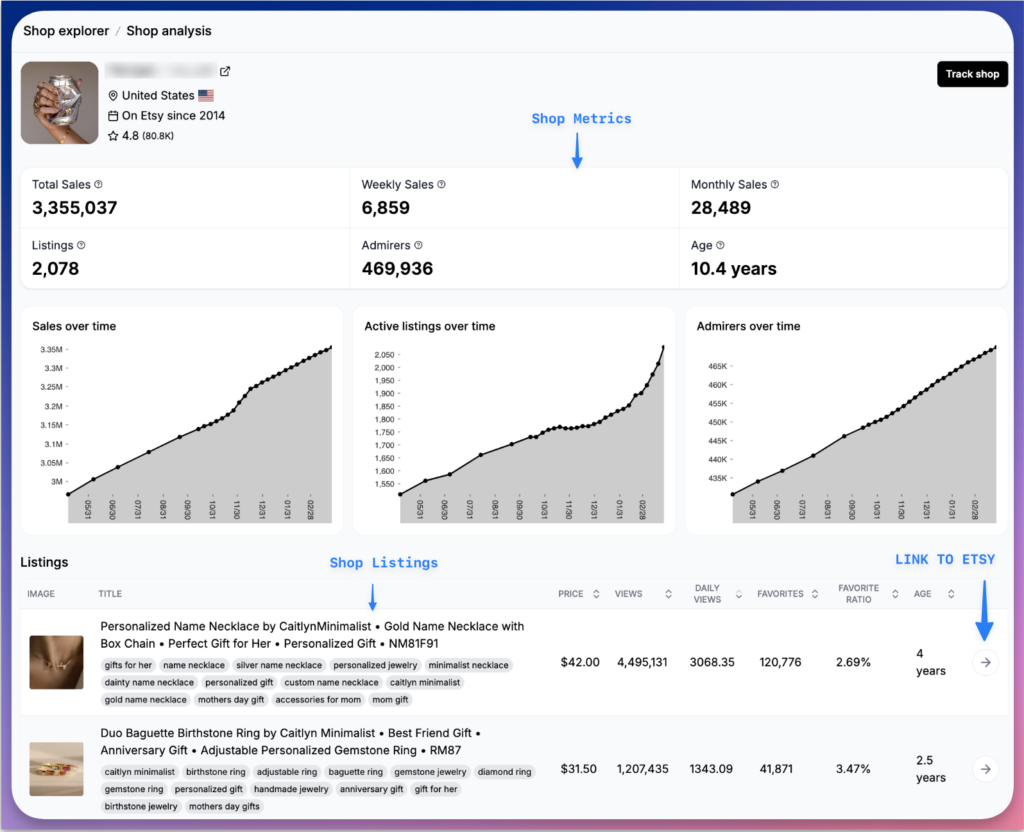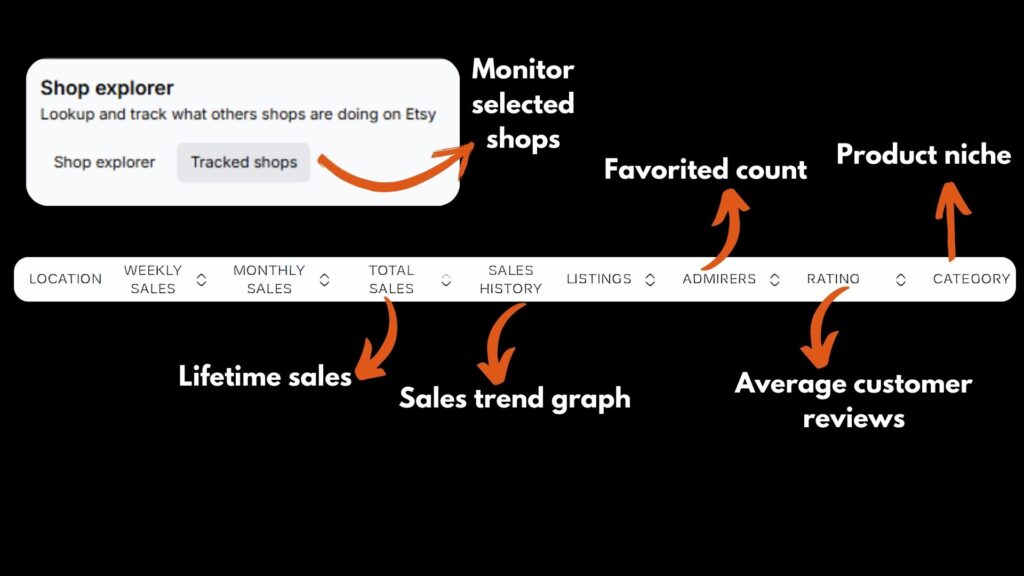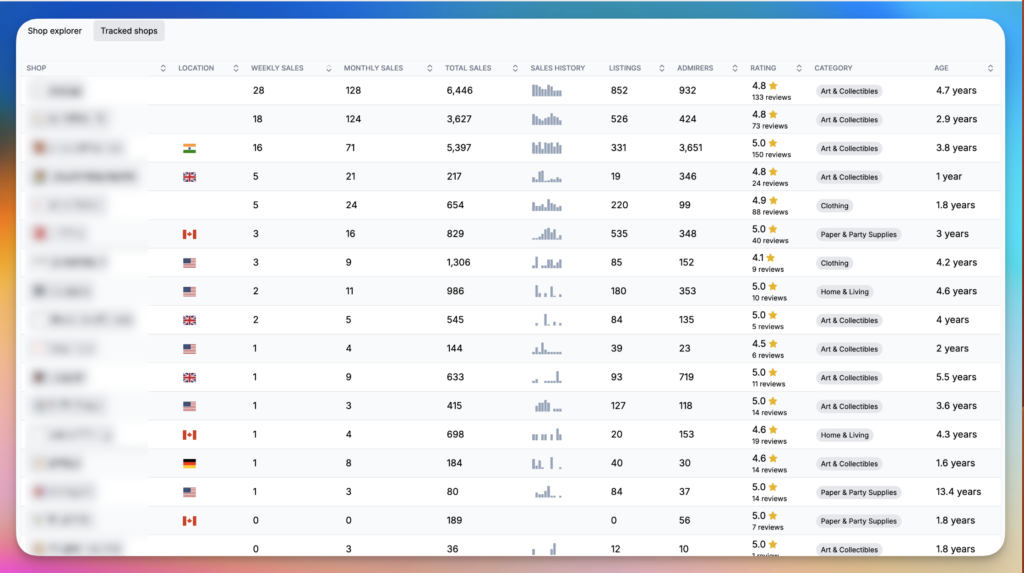How to use Listadum’s Shop Explorer
Published onEtsy’s market place is extremely competitive, with 7 million shops and 92 million buyers, it can sometimes get overwhelming and become a confusing hassle to navigate through Etsy’s algorithm and get consistent sales.
Even though there are thousands of youtube videos, coaches and helping reddit comments, a seller is left confused on how to do proper research for their own niche.
In this blog we are gonna explore some innovative ways to use Listadum’s Shop Explorer feature to do:
- A through market research
- Find inspiration for new products
- Perform a thorough competitor analysis,s or in simple words spy on your favorite shops Without overwhelming yourself!

Listadum’s shop explorer (why every seller needs this tool)
Etsy marketplace is not just about making great products but also understanding your niche!
This can be challenging without spending hours on market research and trend identification.
To keep up to date with your niche, you need to:
- Monitor competition that can dilute your offering. (maybe those sales have slowed down)
- Other products that spawned out of your existing niche and are selling. (niche + niche = new niche)
- Expand your shop to offer more products that fall within your craft and skill set.
- Find shops that are copying your products and selling more than you. (You probably need a strategy refresh)
- Find a list of shops that inspire you to be better. (Your feel-good and dreamer vision board)
Here are a few steps on how you can navigate through Shop Explorer!
Explaining the shop explorer interface
You can access the Shop Explorer using the left tab in your dashboard.

There are two pages under this tab.
Shop Explorer:

Let’s get straight to the business. You will find the shop explorer tab right under keyword explorer. Type in a competitor’s shop name and get instant insights, including:

- Total sales – See how well their products are selling.
- Top performing products – Identify their bestsellers and which listings attract the most traffic.
- Pricing strategy – Compare price points to see how yours stack up.
- Customer engagement – Analyze the number of favorites.
- Best-selling listings – These are the products currently in demand.
- Rising trends – Identify product categories that are gaining traction.
- Seasonal opportunities – Find out which products perform best during specific times of the year.
You can filter these results using the options on the left. For example:
- If you want to find shops that opened last year, you would put 1 in the “max” field under the Age tab.
- If you want to find the top shops in a specific category, you would select that from the categories dropdown list.
- If you want to find top shops with at least 10,000 sales and less than 2 years old in your category, you would select all these from the filters too.
You can also sort the results by clicking on the chevron next to the shop metric.
One you get the list of results, you can click into each result to analyze the selected shop future.

This page will help you
- Analyze your competition
- Understand what product niches are picking up or trending on Etsy,
- What are their top listings
- What tags are they using, etc
Track shops using the Shop Explorer
Keeping a close watch on shops that either compete with you or inspire you helps you monitor their growth over time. You can track these shops easily using the “track shop” feature in the shop explorer.
To track a shop, you need to click on the “track shop” button when you open the shop details page in Listadum. This will add this shop to a list of tracked shops in your Listadum shop explorer.

To access this list, you need to click on the “tracked shops” tab inside the main shop explorer page.

This is how a typical list looks like. You can monitor their weekly sales and number of listings along with other important metrics.

Listadum shop explorer features: A deep dive
Listadum’s shop explorer is a powerful tool designed to give Etsy sellers an edge by providing deep insights into competitor shops and market trends. Here’s how each feature works and how you can use it effectively:
1. Location
What it shows: Displays the country where a shop is based.
How to use it:
- Check if successful shops in your niche are concentrated in a specific region. If so, consider how location impacts buyer preferences.
- Compare shipping options—do competitors in your country offer better shipping times or lower costs?
- Adjust your SEO strategy to target regions where high-performing shops rank well.
2. Weekly sales
What it shows: Tracks the number of sales a shop makes each week.
How to use it:
- Identify short-term performance trends—if a competitor sees a sudden spike, check what’s causing it (new product, ads, or seasonal trends).
- Compare with your own weekly sales to assess competition.
- Spot potential opportunities—if a shop consistently sells well weekly, its strategy may be worth analyzing.
3. Monthly sales
What it shows: Displays total sales for the current month.
How to use it:
- Understand whether a shop’s success is sustainable or fluctuates.
- Compare multiple competitors—who has steady growth versus unpredictable spikes?
- Use this insight to plan your own promotional campaigns during peak months.
4. Total sales
What it shows: The shop’s all-time sales.
How to use it:
- Benchmark against top shops in your niche—are you catching up or falling behind?
- Identify shops that have grown rapidly in a short period—analyze what they’re doing differently.
- Determine whether high sales come from consistent best-sellers or viral products.
5. Sales history
What it shows: Provides a timeline of past sales performance.
How to use it:
- Track sales spikes and try to find out what caused them (ads, influencer promotions, trends, or seasonal shifts).
- See if a competitor’s sales are stable or if they struggle with dips.
- Compare your own sales history to identify opportunities for strategic changes.
6. Listings
What it shows: Displays the total number of active products in a shop.
How to use it:
- Check if competitors with fewer listings outperform those with large inventories—this can guide your product strategy.
- Analyze pricing trends across their listings—are their best-sellers priced differently than their low-performing products?
- Look for frequent updates in their listings—this may indicate that they’re testing new SEO strategies.
7. Admirers (favorites)
What it shows: Number of people who have favorited a shop.
How to use it:
- Compare favorites to actual sales—if a shop has a high favorite ratio but low sales, their pricing or listing presentation may be an issue.
- See if certain products attract more admirers and replicate their engagement strategies. Look at bestseller tags, pricing, and product descriptions to identify emerging trends.
- Test promotions to encourage favoriting, as this can improve visibility in Etsy’s algorithm.
8. Rating & reviews
What it shows: Displays the shop’s average customer rating and feedback.
How to use it:
- Identify recurring praise and complaints—learn from what customers love or dislike.
- Check if a competitor is losing sales due to negative feedback—this can present an opportunity for your shop.
- Use positive review themes as inspiration for improving your own product descriptions and images.
9. Category analysis
What it shows: Indicates the shop’s primary category or niche.
How to use it:
- Identify whether the niche is overcrowded or has growth potential.
- Compare top-performing products in your category to see if there are sub-niches you can explore.
- Look at how your competitors structure their categories and optimize yours accordingly.
How to navigate Listadum’s shop explorer efficiently
- Start with competitor research – Enter the name of a competitor’s shop to get a full breakdown of their sales trends, listings, and performance metrics.
- Compare multiple shops – Use filters to compare shops in the same niche and find patterns in sales, pricing, and product variations.
- Analyze what’s working – Check which shops have high conversion rates and identify the factors contributing to their success.
- Spot growth opportunities – Look at sales history and seasonal spikes to align your marketing efforts with demand trends.
- Refine your strategy – Adjust pricing, optimize listings, and introduce new products based on data-driven insights from shop explorer.
Conclusion
We know that staying ahead in the Etsy marketplace means understanding your competition and spotting trends early. But keeping track of all these insights doesn’t have to be overwhelming. With Listadum’s Shop Explorer, you can make data-driven decisions effortlessly, whether it’s optimizing your pricing, identifying market gaps, or tracking top-performing competitors.
Hopefully, this guide has helped you understand how to leverage Shop Explorer effectively. If you have any questions, feel free to reach out to us in our Discord community, via chat, or by email.
Listadum is here to help you grow!